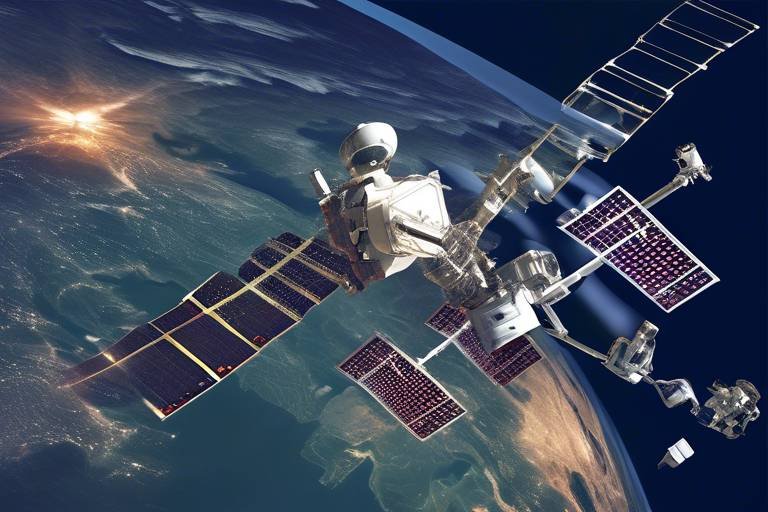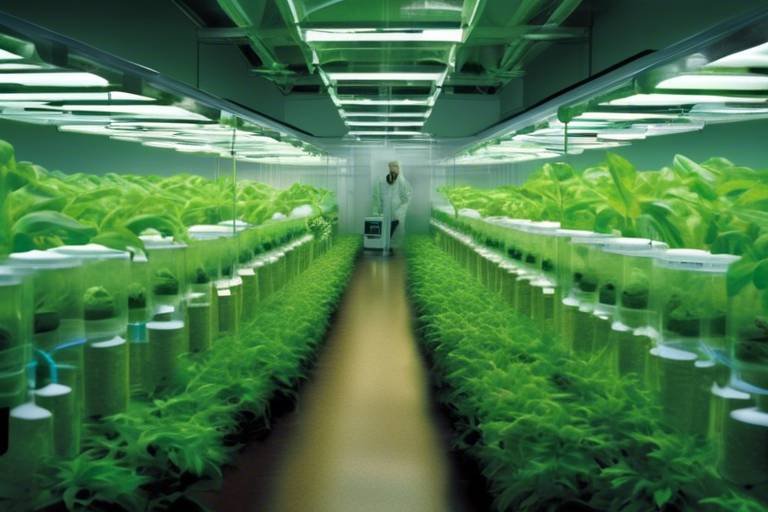Future of Telecommunications - The Role of Satellites
In today's rapidly evolving world, the future of telecommunications is increasingly intertwined with the capabilities of satellites. These remarkable technological marvels are not just floating pieces of metal in the sky; they are vital components of our global communication infrastructure. As we delve into the transformative impact of satellites on telecommunications, we uncover how they are reshaping the way we connect, communicate, and access information. From providing internet access to the most remote corners of the globe to facilitating instantaneous communication across vast distances, satellites are paving the way for a more interconnected future.
The journey of satellite technology has been nothing short of revolutionary. Imagine a world where even the most isolated communities can access high-speed internet and engage in real-time communications. This is not just a dream; it's becoming a reality thanks to recent advancements in satellite technology. Innovations such as Low Earth Orbit (LEO) satellites are playing a pivotal role in this transformation, offering lower latency and higher bandwidth compared to traditional geostationary satellites. This is akin to upgrading from a bicycle to a sports car in terms of speed and efficiency.
Moreover, the impact of satellites on telecommunications extends beyond mere connectivity. They are also crucial in bridging the digital divide, especially in rural areas where traditional broadband infrastructure may be lacking. By providing access to high-speed internet, satellites are fostering economic growth, enhancing educational opportunities, and even improving healthcare services in underserved regions. Imagine a student in a remote village being able to attend online classes or a farmer accessing real-time weather data to optimize crop yields. The possibilities are endless!
However, it's essential to acknowledge that the path forward is not without its challenges. Satellite communications face several hurdles, including signal interference, the proliferation of space debris, and the complexities of regulatory frameworks. These challenges necessitate innovative solutions and collaborative efforts among stakeholders to ensure the continued growth and reliability of satellite telecommunications. Just as a gardener must tend to their plants to ensure healthy growth, the telecommunications industry must address these challenges to cultivate a thriving satellite ecosystem.
As we look to the future, emerging trends such as the integration of artificial intelligence and the Internet of Things (IoT) are set to redefine the landscape of satellite telecommunications. This integration will enhance efficiency, streamline service delivery, and open up new avenues for communication. For instance, AI can optimize satellite operations, predict maintenance needs, and improve data analytics, while IoT devices can leverage satellite networks to connect and communicate seamlessly, regardless of location.
In conclusion, the role of satellites in the future of telecommunications is not just about technology; it’s about creating a more connected world. As we continue to innovate and address the challenges ahead, the potential for satellites to transform global communication is boundless. Whether it’s through enhancing rural connectivity, expanding global coverage, or integrating with terrestrial networks, satellites are at the forefront of a telecommunications revolution that promises to change lives and shape the future.
- What are Low Earth Orbit (LEO) satellites?
LEO satellites are satellites that orbit the Earth at altitudes between 180 to 2,000 kilometers. They provide lower latency and higher bandwidth compared to traditional geostationary satellites. - How do satellites improve internet access in rural areas?
Satellites can deliver high-speed internet access to remote areas where traditional broadband infrastructure is unavailable, bridging the digital divide and fostering economic growth. - What challenges do satellite communications face?
Satellite communications encounter challenges such as signal interference, space debris, and regulatory issues that need to be addressed for sustainable growth. - How will AI and IoT impact satellite telecommunications?
The integration of AI and IoT will enhance operational efficiency, improve data analytics, and enable seamless connectivity across devices, transforming the telecommunications landscape.

Advancements in Satellite Technology
In recent years, the world of telecommunications has witnessed a remarkable transformation, thanks to groundbreaking advancements in satellite technology. These innovations have not only enhanced communication capabilities but have also paved the way for a more connected world. Imagine being able to send and receive data at lightning speed, even from the most remote corners of the globe. That's the power of today's satellites!
One of the most significant developments is the shift from traditional geostationary satellites to Low Earth Orbit (LEO) satellites. Unlike their predecessors, which orbit at an altitude of around 36,000 kilometers, LEO satellites operate at altitudes between 180 to 2,000 kilometers. This lower orbit drastically reduces signal latency, making real-time communication more feasible. Think of it like having a conversation with a friend who is just a few blocks away instead of someone on the other side of the world; it’s much easier and quicker!
Moreover, advancements in satellite design and manufacturing processes have led to smaller, more efficient satellites. These miniature marvels can be launched in clusters, creating a network that blankets the Earth with coverage. For instance, companies like SpaceX and OneWeb are deploying constellations of LEO satellites, which can significantly improve internet access in underserved regions. A recent report indicated that these systems could potentially deliver internet speeds exceeding 1 Gbps, which is a game-changer for users in remote areas.
Furthermore, the integration of artificial intelligence (AI) in satellite operations is enhancing data processing capabilities. AI algorithms can analyze vast amounts of data collected from satellites, optimizing bandwidth distribution and improving overall service quality. This means that users can enjoy faster and more reliable connections, whether they are streaming their favorite shows or participating in video conferences.
However, it's not just about speed; the advancements also focus on coverage. With the ability to provide internet access to previously unreachable locations, satellites are becoming the backbone of global communication. For example, rural communities that once struggled with poor connectivity can now participate in the digital economy, accessing online education, telehealth services, and remote work opportunities.
In summary, the advancements in satellite technology are reshaping the telecommunications landscape. With lower latency, enhanced coverage, and the integration of AI, satellites are not just tools for communication; they are gateways to a more connected future. As we look ahead, it’s clear that these technological strides will continue to play a pivotal role in bridging the digital divide and fostering global connectivity.

Satellite Internet vs. Traditional Broadband
When it comes to choosing an internet service, the debate between satellite internet and traditional broadband is heating up. Both options have their unique advantages and disadvantages, and understanding these can make a world of difference in your online experience. So, what exactly sets them apart? Let’s dive into the details!
First off, let’s talk about speed. Traditional broadband, particularly fiber-optic connections, can deliver lightning-fast speeds, often exceeding 1 Gbps. This means that streaming your favorite shows, gaming online, or video conferencing can be done seamlessly. On the other hand, satellite internet typically offers lower speeds, ranging from 12 Mbps to 100 Mbps, depending on the provider and technology used. While this might sound sufficient for casual browsing and streaming, it can become a bottleneck for heavy users.
Now, let’s discuss latency. Latency refers to the time it takes for data to travel from your device to the server and back. Traditional broadband generally has a latency of around 20 to 50 milliseconds, making it ideal for real-time applications like online gaming. In contrast, satellite internet suffers from higher latency, often exceeding 600 milliseconds due to the long distances signals must travel to and from satellites in orbit. This can lead to noticeable delays, which can be frustrating for users who rely on instant feedback.
Another critical factor is accessibility. Satellite internet shines in this area. It can reach even the most remote locations where traditional broadband infrastructure simply doesn’t exist. If you live in a rural area or a place where laying cables is impractical, satellite internet could be your best bet. Conversely, traditional broadband is widely available in urban and suburban areas, but may not extend to more isolated regions.
| Feature | Satellite Internet | Traditional Broadband |
|---|---|---|
| Speed | 12 Mbps - 100 Mbps | Up to 1 Gbps |
| Latency | 600 ms+ | 20 - 50 ms |
| Accessibility | Available in remote areas | Limited to urban/suburban areas |
| Data Caps | Often have limits | Typically unlimited |
Lastly, let’s touch on data caps. Many satellite internet plans come with strict data limits, meaning once you exceed your allotted data, your speeds may be throttled or additional charges may apply. Traditional broadband providers, especially fiber-optic ones, often offer unlimited data, allowing you to stream, download, and browse without worrying about hitting a limit.
In conclusion, the choice between satellite internet and traditional broadband largely depends on your specific needs and circumstances. If you prioritize speed and low latency for activities like gaming or streaming, traditional broadband is your best bet. However, if you live in a remote area and need a reliable connection, satellite internet can be a lifesaver. As technology continues to evolve, the lines between these two options may blur, but for now, understanding their differences is crucial for making an informed decision.
- Is satellite internet faster than broadband? Not necessarily. Traditional broadband, especially fiber-optic, typically offers faster speeds than satellite internet.
- Can I use satellite internet for gaming? While you can, the high latency of satellite internet may result in lag, making it less ideal for real-time gaming.
- Are there data caps with satellite internet? Yes, many satellite internet providers impose data limits, which can affect your usage.
- Is traditional broadband available in rural areas? It can be limited, which is where satellite internet shines for providing access.

Low Earth Orbit Satellites
Low Earth Orbit (LEO) satellites are truly changing the game in the world of telecommunications. Imagine a constellation of satellites buzzing around the Earth at altitudes ranging from just 180 to 2,000 kilometers. These satellites are not just floating in space; they are working tirelessly to provide us with faster and more reliable internet connections. Unlike traditional geostationary satellites, which orbit at approximately 35,786 kilometers, LEO satellites can offer significantly lower latency. This means that the time it takes for data to travel from your device to the satellite and back is dramatically reduced. It’s like trading in a slow, old car for a sleek, modern sports vehicle—everything happens much quicker!
One of the most exciting aspects of LEO satellites is their ability to deliver high bandwidth. With the increasing demand for data—thanks to streaming services, online gaming, and the ever-growing Internet of Things (IoT)—these satellites are stepping up to the plate. They can handle multiple connections simultaneously, making them a fantastic option for both urban and rural areas. In fact, a recent study showed that LEO satellites can provide internet speeds comparable to fiber-optic connections. That’s a big deal for people living in remote areas where traditional broadband options are limited or nonexistent.
However, the revolution brought by LEO satellites isn't just about speed and bandwidth. It’s also about accessibility. These satellites are designed to cover vast areas, ensuring that even the most isolated communities can connect to the digital world. For instance, companies like SpaceX with their Starlink project are already deploying thousands of LEO satellites to create a network that spans the globe. This is a game-changer for rural connectivity, as it allows for economic growth and educational opportunities that were previously out of reach.
But let's not forget the challenges. With the rapid deployment of LEO satellites, concerns about space debris are on the rise. Each satellite contributes to the growing population of objects in orbit, which increases the risk of collisions. Moreover, the regulatory landscape is still catching up with the technology, making it essential for companies to work closely with governments and international organizations to ensure safe and responsible satellite operations.
In summary, LEO satellites are not just a technological advancement; they represent a significant shift in how we think about global connectivity. They are paving the way for a future where everyone, regardless of their geographical location, has access to high-speed internet. The potential is enormous, and as we continue to innovate and address existing challenges, the sky is truly the limit!
- What are Low Earth Orbit satellites? LEO satellites orbit the Earth at low altitudes, providing faster communication and lower latency compared to traditional satellites.
- How do LEO satellites improve internet speed? They reduce the distance data has to travel, which decreases latency and allows for higher bandwidth connections.
- Are there any challenges with LEO satellites? Yes, challenges include space debris, regulatory issues, and the need for ground infrastructure to support them.
- What companies are leading in LEO satellite technology? Companies like SpaceX (Starlink), OneWeb, and Amazon (Project Kuiper) are at the forefront of LEO satellite deployment.

Impact on Rural Connectivity
The advent of Low Earth Orbit (LEO) satellites is nothing short of a game changer for rural connectivity. For years, many rural communities have been left in the digital dark, struggling with slow internet speeds and unreliable connections. But now, with the deployment of LEO satellites, high-speed internet is becoming a reality for these underserved areas. Imagine being able to stream your favorite shows, attend online classes, or even run a business from the comfort of your home in the countryside—this is the promise that LEO satellites bring.
These satellites orbit the Earth at much lower altitudes than traditional geostationary satellites, which allows them to provide lower latency and higher bandwidth. This means that users in rural areas can experience internet speeds that were previously unimaginable. In fact, studies have shown that LEO satellite networks can deliver speeds comparable to those of urban broadband connections. This is a significant leap forward, especially when you consider that traditional satellite internet often suffers from high latency due to the long distances signals must travel.
Furthermore, LEO satellites can be deployed more rapidly and at a lower cost than traditional satellite systems. This is particularly important for rural areas that have been historically neglected by terrestrial internet providers. By utilizing a constellation of satellites working in harmony, these systems can blanket vast areas with coverage, ensuring that even the most remote locations can access essential communication services.
To illustrate the potential impact, consider the following table that compares traditional satellite services with LEO satellite services:
| Feature | Traditional Satellite | LEO Satellite |
|---|---|---|
| Latency | 600 ms or more | 20-40 ms |
| Speed | Up to 25 Mbps | Up to 100 Mbps |
| Coverage | Limited, often urban-focused | Global, including rural areas |
| Deployment Time | Years | Months |
In addition to enhancing internet access, LEO satellites also foster economic growth and educational opportunities in rural regions. With reliable internet, local businesses can reach broader markets, farmers can access real-time data to improve crop yields, and students can participate in online learning without the frustration of buffering or dropped connections.
However, the impact of LEO satellites goes beyond just connectivity. They also encourage community development and social engagement. With better access to information and communication tools, rural residents can participate more actively in social and civic activities, bridging the gap between urban and rural lifestyles. This newfound connectivity can lead to a more informed populace, capable of making better decisions and advocating for their needs.
As we look to the future, the role of LEO satellites in transforming rural connectivity is clear. They not only promise to enhance the quality of life for many but also serve as a catalyst for economic development and social progress. The digital divide is slowly closing, and with it, the opportunities for rural communities to thrive in an increasingly connected world.
- What are LEO satellites? LEO satellites are satellites that orbit the Earth at low altitudes, typically between 180 to 2,000 kilometers, allowing for lower latency and higher bandwidth communication.
- How do LEO satellites improve rural internet access? They provide high-speed internet connectivity to remote areas, overcoming the limitations faced by traditional satellite systems.
- What challenges do LEO satellites face? Challenges include signal interference, space debris, and regulatory hurdles that need to be addressed for successful deployment.
- Are LEO satellites environmentally friendly? As their deployment increases, it is crucial to consider their environmental impact and promote sustainable practices.

Global Coverage and Accessibility
In today's interconnected world, the importance of global coverage and accessibility cannot be overstated. Traditional telecommunications methods often struggle to reach remote and underserved areas, leaving millions without reliable communication options. However, the advent of Low Earth Orbit (LEO) satellites has changed the game. These satellites operate at much lower altitudes than their geostationary counterparts, enabling them to provide robust internet services to even the most isolated regions of the globe.
Imagine a farmer in a remote village who, until recently, had to rely on intermittent and slow internet connections. With the introduction of LEO satellites, that same farmer can now access high-speed internet, allowing them to leverage online resources, connect with markets, and even utilize smart farming technologies. This transformation is not just a technological upgrade; it's a lifeline that fosters economic growth and educational opportunities. As we explore the impact of these satellites, it's essential to recognize how they are actively bridging the digital divide.
One of the remarkable features of LEO satellites is their ability to provide global coverage. Unlike traditional satellites that can only cover specific areas due to their fixed positions, LEO satellites create a network that blankets the Earth, ensuring that even the most remote locations can access essential communication services. This capability is vital for various applications, including disaster response, remote healthcare, and education. In fact, a recent study highlighted that:
| Region | Access Before LEO Satellites | Access After LEO Satellites |
|---|---|---|
| Rural Areas | 30% Connectivity | 90% Connectivity |
| Isolated Islands | 10% Connectivity | 85% Connectivity |
| Mountainous Regions | 25% Connectivity | 80% Connectivity |
This table illustrates the profound impact of LEO satellites on connectivity in various regions. The increase in access not only empowers individuals but also enhances community resilience. For instance, in areas prone to natural disasters, having reliable communication can mean the difference between life and death. Emergency services can coordinate more effectively, and residents can receive critical information about safety protocols.
Furthermore, the accessibility provided by LEO satellites promotes inclusivity. Students in remote areas can participate in online classes, professionals can work from anywhere, and families can stay connected regardless of their geographic location. This shift towards improved accessibility is not merely about internet speed; it's about creating opportunities for social equity and economic development.
As we look to the future, the potential for LEO satellites to enhance global coverage and accessibility is enormous. With ongoing advancements in technology and infrastructure, we can expect to see even greater improvements in communication capabilities. The world is becoming more interconnected, and with it comes the responsibility to ensure that everyone, regardless of their location, has access to the digital world.
- What are LEO satellites? LEO satellites are satellites that orbit the Earth at low altitudes, typically between 180 to 2,000 kilometers, providing lower latency and higher bandwidth for communication.
- How do LEO satellites improve connectivity? They create a network that covers vast areas, allowing for high-speed internet access even in remote locations that traditional satellites cannot reach.
- What are the benefits of improved global coverage? Enhanced global coverage leads to better access to education, healthcare, and economic opportunities, especially in underserved regions.
- Are there any challenges with satellite communication? Yes, challenges include signal interference, space debris, and regulatory issues that need to be addressed for optimal performance.

Challenges Facing Satellite Communications
While the advancements in satellite communications are nothing short of revolutionary, they come with a unique set of challenges that can hinder their full potential. One of the most pressing issues is signal interference. This can occur due to various factors, such as weather conditions, physical obstructions, or even interference from other electronic devices. Imagine trying to have a clear conversation in a crowded room filled with noise; that’s what satellite signals often contend with. The clarity and reliability of communication can suffer greatly, leading to frustrating experiences for users.
Another significant challenge is the issue of space debris. As more satellites are launched into orbit, the risk of collisions increases. This debris can damage operational satellites, disrupt services, and create even more debris in a vicious cycle. According to recent studies, there are over 34,000 pieces of debris larger than 10 cm orbiting Earth, and this number is expected to grow. The implications of this are profound, as a single collision could lead to a catastrophic chain reaction, putting countless satellites—and the services they provide—at risk.
Regulatory hurdles also pose a challenge for satellite communications. The space above us is governed by a complex web of international treaties and national regulations that can vary significantly from one country to another. This creates a bureaucratic maze that companies must navigate to secure the necessary licenses and permissions to operate. The process can be time-consuming and costly, often delaying the deployment of new technologies and services. In a world that thrives on speed and efficiency, these delays can be detrimental to innovation and market competitiveness.
Additionally, the high costs associated with launching and maintaining satellites can be a barrier for many companies, especially startups looking to enter the market. The investment required for satellite technology is substantial, and the return on investment can take years to materialize. This financial strain can limit the number of players in the market, which in turn stifles competition and innovation. To illustrate, here’s a table highlighting the costs associated with different aspects of satellite communications:
| Aspect | Estimated Cost (USD) |
|---|---|
| Satellite Launch | 50 million - 500 million |
| Satellite Manufacturing | 10 million - 300 million |
| Ground Station Setup | 1 million - 10 million |
| Operational Costs (Annual) | 1 million - 20 million |
In conclusion, while satellites hold incredible promise for transforming telecommunications, addressing these challenges is crucial. The industry must innovate not only in technology but also in regulatory frameworks and sustainable practices to ensure a robust future for satellite communications. Only by overcoming these hurdles can we fully realize the potential of satellite technology in bridging the digital divide and enhancing global connectivity.
- What is the main challenge faced by satellite communications? Signal interference and space debris are among the top challenges.
- How does space debris affect satellite operations? It can cause collisions, leading to service disruptions and potential loss of satellites.
- Why are regulatory hurdles significant? They can delay satellite deployment and increase operational costs.
- What are the costs associated with satellite communications? Launching, manufacturing, and maintaining satellites can be very expensive.

Future Trends in Satellite Telecommunications
The future of satellite telecommunications is not just a distant dream; it's unfolding right before our eyes. With the rapid pace of technological advancements, we are on the brink of a revolution that will redefine how we connect with the world. Imagine a landscape where communication barriers are virtually nonexistent, where even the most isolated villages can access high-speed internet. This is the promise of emerging trends in satellite technology. One of the most exciting developments is the integration of artificial intelligence (AI) and the Internet of Things (IoT). These technologies are set to enhance the efficiency and effectiveness of satellite communications, enabling smarter data management and better service delivery.
AI can analyze vast amounts of data in real-time, optimizing satellite operations and improving user experiences. For instance, AI algorithms can predict peak usage times and adjust bandwidth allocation accordingly, ensuring that users receive the best possible service. Similarly, IoT devices can communicate with satellites to transmit data from remote sensors, allowing for applications in agriculture, disaster management, and environmental monitoring. This interconnectedness is not just a technological marvel; it's a game-changer for industries that rely on timely and accurate information.
Another critical trend is the increasing collaboration between satellite networks and ground infrastructure. As we move towards a more integrated communication ecosystem, the hybrid model that combines satellite and terrestrial networks will become essential. This collaboration will enhance coverage and reliability, particularly in urban areas where demand for bandwidth is skyrocketing. For example, satellite networks can provide backup connectivity during natural disasters when ground networks might be compromised. By working together, these systems can ensure that communication remains uninterrupted, no matter the circumstances.
Furthermore, as we witness a surge in satellite launches, we must also consider the environmental impact of these deployments. The space around our planet is becoming increasingly crowded, and the issue of space debris is a significant concern. Future trends will likely focus on sustainable practices, such as designing satellites that can deorbit safely at the end of their life cycle. Companies will need to prioritize environmental responsibility, ensuring that the benefits of satellite telecommunications do not come at the expense of our planet's health.
To summarize, the future of satellite telecommunications is bright, characterized by innovation and collaboration. The integration of AI and IoT, alongside a commitment to sustainable practices, will pave the way for a more connected and accessible world. As we embrace these trends, we can look forward to a future where connectivity is not just a luxury but a fundamental right for everyone, everywhere.
- What role does AI play in satellite telecommunications?
AI optimizes satellite operations, enhances user experiences, and manages data more efficiently. - How do satellites improve rural connectivity?
Satellites provide high-speed internet access to underserved areas, bridging the digital divide. - What are the environmental concerns associated with satellites?
Space debris and the sustainability of satellite launches are critical issues that need addressing. - How will satellite technology evolve in the next decade?
We can expect more integration with IoT, improved bandwidth, and enhanced reliability through hybrid models.

Collaboration with Ground Infrastructure
In the ever-evolving landscape of telecommunications, the synergy between satellite technology and ground infrastructure is becoming increasingly vital. Just like a well-oiled machine, where each cog plays a crucial role, the collaboration between these two entities can significantly enhance the overall performance and reliability of communication networks. Imagine trying to enjoy a concert without sound engineers and equipment; satellites alone can't provide comprehensive connectivity without the support of robust terrestrial systems.
To illustrate this point, consider the following key aspects of collaboration:
- Data Integration: Ground stations are essential for managing the data that satellites transmit. They act as the bridge between satellite networks and the end-users, ensuring that information flows smoothly and efficiently.
- Network Redundancy: By integrating satellite systems with existing ground networks, service providers can create a more resilient infrastructure. If one system fails, the other can pick up the slack, minimizing downtime and enhancing user experience.
- Cost Efficiency: Collaborating with ground infrastructure allows satellite operators to reduce costs associated with launching and maintaining their systems. By leveraging existing terrestrial networks, they can provide services at a lower price point, making satellite internet more accessible.
Moreover, this collaboration paves the way for a hybrid model of connectivity that combines the best of both worlds. For instance, during natural disasters or emergencies, when ground infrastructure may be compromised, satellites can step in to provide critical communication services. This dual approach not only enhances reliability but also promotes a sense of security among users, knowing that they have multiple channels for communication.
As we look to the future, the integration of technologies such as artificial intelligence and the Internet of Things (IoT) will further strengthen this collaboration. AI can optimize data routing between satellites and ground stations, while IoT devices can provide real-time feedback on network performance, enabling quicker adjustments and improved service delivery. Just as a conductor leads an orchestra, ensuring that each instrument plays harmoniously, the collaboration between satellite and ground infrastructure will orchestrate a new era of connectivity.
In conclusion, the collaboration between satellite technology and ground infrastructure is not just a beneficial partnership; it is a necessity for the future of telecommunications. As we continue to innovate and expand our capabilities, this synergy will play a pivotal role in ensuring that everyone, regardless of their geographical location, has access to reliable and high-speed internet services.
1. What is the role of ground infrastructure in satellite communications?
Ground infrastructure acts as the intermediary between satellites and users, managing data flow and ensuring reliable connectivity.
2. How does collaboration enhance network reliability?
By integrating satellite systems with terrestrial networks, service providers can create redundancy, allowing one system to support the other in case of failures.
3. What technologies are influencing the future of satellite communications?
Emerging technologies like artificial intelligence and IoT are set to optimize data management and improve service delivery in satellite communications.

Environmental Considerations
The rapid expansion of satellite telecommunications brings with it a host of environmental considerations that cannot be overlooked. As we launch more satellites into orbit, we must ask ourselves: what impact do these technologies have on our planet? Just like any booming industry, satellite communications has its environmental footprint, and it's crucial to understand both the challenges and the solutions that can help mitigate these effects.
One of the primary environmental concerns is the issue of space debris. As more satellites are launched, the risk of collisions increases, resulting in fragments that orbit the Earth at high speeds. These pieces of debris can pose a significant threat not only to operational satellites but also to the International Space Station and other spacecraft. According to recent estimates, there are over 34,000 pieces of debris larger than 10 cm currently in orbit. This situation calls for international cooperation to develop guidelines and technologies aimed at debris mitigation and removal.
Furthermore, the production and launch of satellites contribute to carbon emissions and other pollutants. The rocket launches required to place these satellites into orbit consume vast amounts of fuel, releasing greenhouse gases and other harmful substances into the atmosphere. Therefore, the industry is under pressure to innovate and find more sustainable launch technologies, such as reusable rockets and alternative fuels, to reduce their ecological impact.
Another consideration is the impact on wildlife. The launch facilities and ground stations needed for satellite communications can disrupt local ecosystems. For instance, the construction and operation of these facilities may encroach on natural habitats, affecting flora and fauna. It's essential for companies to conduct thorough environmental assessments before establishing new sites and to implement measures that minimize disruption to local wildlife.
In light of these challenges, the satellite telecommunications industry is exploring various strategies to promote sustainability. Some of these include:
- Developing green technologies for satellite manufacturing and launch operations.
- Implementing de-orbiting plans for satellites at the end of their operational lives to minimize space debris.
- Collaborating with environmental organizations to ensure compliance with ecological standards.
Ultimately, as we advance into a future dominated by satellite telecommunications, we must adopt a holistic approach that balances technological progress with environmental stewardship. By prioritizing sustainable practices and fostering innovation, we can ensure that the benefits of satellite communications do not come at the cost of our planet's health.
What is space debris, and why is it a concern?
Space debris refers to defunct satellites, spent rocket stages, and fragments from collisions that remain in orbit around the Earth. It poses a risk to operational satellites and other spacecraft, potentially leading to catastrophic collisions.
How do satellite launches impact the environment?
Satellite launches contribute to carbon emissions and pollution due to the fuel consumed during rocket launches. The industry is exploring cleaner technologies to mitigate these impacts.
What measures are being taken to reduce the environmental impact of satellites?
The satellite telecommunications industry is working on developing green technologies, implementing de-orbiting plans for defunct satellites, and collaborating with environmental organizations to minimize ecological disruption.
Frequently Asked Questions
- What are the main advantages of satellite internet over traditional broadband?
Satellite internet offers unique benefits such as broader coverage, especially in rural and remote areas where traditional broadband may not reach. It can provide connectivity where terrestrial infrastructure is lacking, making it a vital option for many users. However, it often comes with higher latency and varying speeds compared to fiber or cable connections.
- How do Low Earth Orbit (LEO) satellites improve telecommunications?
LEO satellites operate at much lower altitudes than traditional geostationary satellites, which significantly reduces latency and increases bandwidth. This means faster data transmission and a more responsive internet experience, making them a game-changer for users who rely on real-time communication.
- What challenges do satellite communications face?
Despite their benefits, satellite communications encounter several challenges, including signal interference caused by weather conditions, the growing issue of space debris, and regulatory hurdles that can complicate deployment and operation. These factors can impact service reliability and coverage consistency.
- How are satellites helping to bridge the digital divide?
Satellites, particularly LEO satellites, are playing a crucial role in providing high-speed internet access to underserved rural areas. By offering connectivity where traditional services may not be available, they foster economic growth, educational opportunities, and overall community development.
- What future trends should we expect in satellite telecommunications?
Future trends in satellite telecommunications include the integration of artificial intelligence to optimize network performance and the Internet of Things (IoT) for enhanced connectivity. These advancements will likely lead to more efficient service delivery and improved user experiences.
- How do satellite networks collaborate with ground infrastructure?
Successful satellite telecommunications increasingly rely on collaboration with terrestrial networks to create a hybrid model. This approach maximizes coverage and reliability, ensuring users have access to consistent and high-quality service regardless of their location.
- What environmental considerations are associated with satellite deployments?
As satellite deployments increase, it's essential to address their environmental impacts, such as space debris and energy consumption. Promoting sustainable practices in satellite technology and operations will be crucial for the long-term viability of satellite telecommunications and the preservation of our space environment.



















